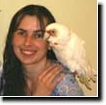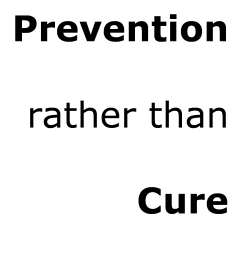

My goal with this article is to make the understanding of Dr. Marshall's Health Programmes as simple as possible for you. I guarantee that if you use the system as recommended, you will see not only wonderfully healthy birds, but also simplicity of feeding, especially with Gouldians who can be such finicky eaters.
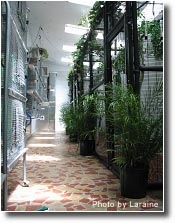 In November 2003 I moved my home from one location in
In November 2003 I moved my home from one location in
During the year leading up to my move I adjusted their diet and supplement schedule based upon Dr. Marshall's Health Programmes. Since they were not to be set up to breed during what would have been their natural breeding cycle in the Fall and Winter of 2003-2004, after their yearly molt in the Spring of 2003 they were put on an extended Resting Programme until their yearly molt rolled around again in the Spring of 2004. This was done to keep them from coming into breeding condition. Once the molt was completed, they again went onto the Resting Programme and were then brought into breeding condition for the 2004-2005 Breeding Season.
This schedule clearly demonstrated to me the ability to control a bird's seasonal cycles based upon diet, lighting and naturally occurring heat as discussed in another article The Cycle of the Seasons.
Leap of Faith
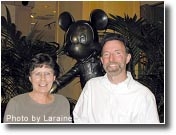 I have to admit, and I said this directly to Dr. Marshall in January 2005, when we met in
I have to admit, and I said this directly to Dr. Marshall in January 2005, when we met in
One statement that I had read in Dr. Marshall's Gouldian & Finch Health Book was that "breeding diets that do not include soaked or sprouted seed, but they do incorporate TurboBooster, e-Powder and F-Vite, provide a good alternative to the potential contamination problems associated with soaked or sprouted seed". This stuck in my mind because so often I am told by other bird owners that they are too busy to make fresh eggfoods and give the birds fresh greens each day, let alone sprout seeds with all the time and dangers that can entail. They want an "easy" way to maintain their birds. I wanted to see if breeding birds could successfully raise healthy chicks without those time consuming chores. Since Dr. Marshall claimed that using TurboBooster can eliminate the need for sprouted seed during the breeding season, I wanted to prove to myself that it could do just that. In good conscience I wanted to be able to tell other bird keepers that this system would keep their birds healthy, happy and capable of raising strong healthy chicks.
In order to try this "bare bones" approach during the next breeding cycle and since I didn't want to abruptly change their diet regimen when the breeding season started, for the year preceding it I applied the 3 core products that are part of all the Health Programmes (TurboBooster, F-Vite and e-Powder) to the dry seed mix, and added the Megamix, DufoPlus and Ioford to the drinking water. I did provide fresh greens several times per week for the next year, but "bare bones" would mean excluding fresh hard-boiled eggs and sprouted seed or millet sprays during the next breeding season.
Here’s how it works…
The way that Dr. Marshall's Health Programmes work, the frequency of use of each of the products change throughout the Resting, Molting, Breeding and Juvenile seasons, but the core products remain the same. The following charts illustrate the product frequency changes during each Seasonal Cycle.
Mixing Rates for Small Quantities - Click Here
Download & Print these charts full size by Clicking on the Links Below:
Spring Molting Programme Chart
Juvenile Gouldian Programme Chart
Austerity Program for Finch & Canaries Chart
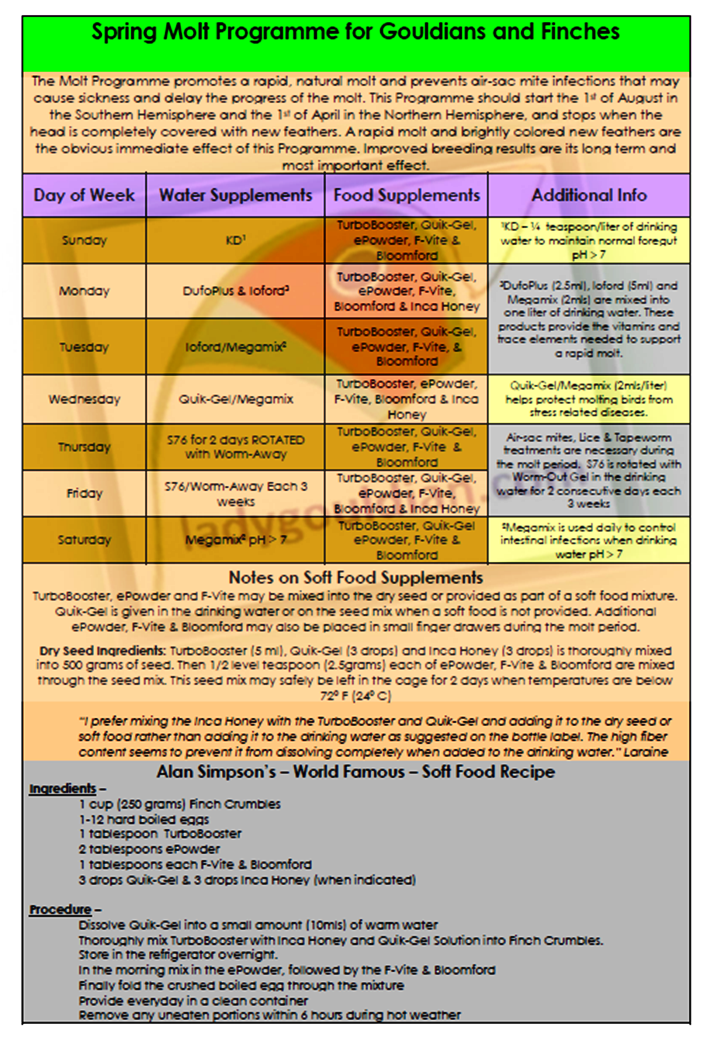

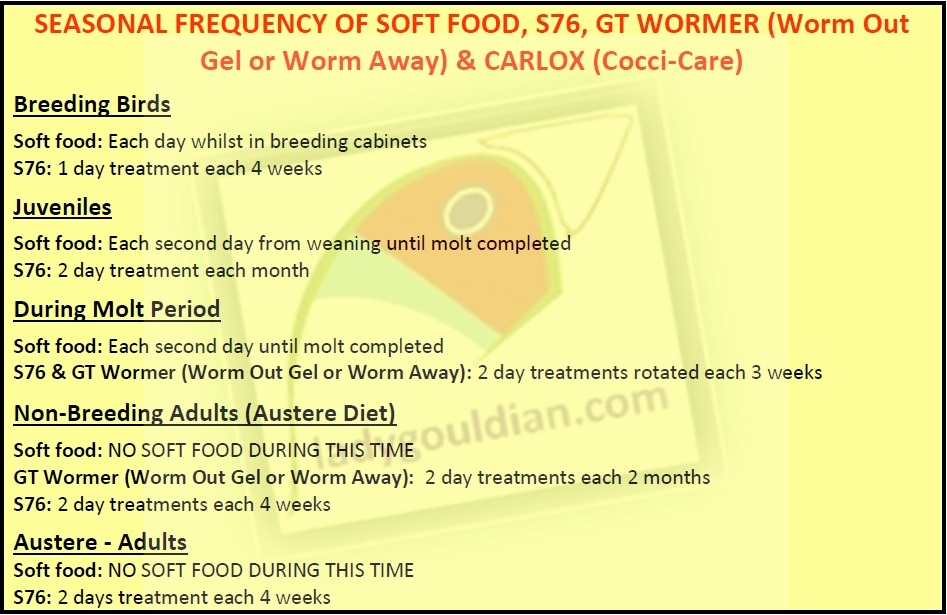
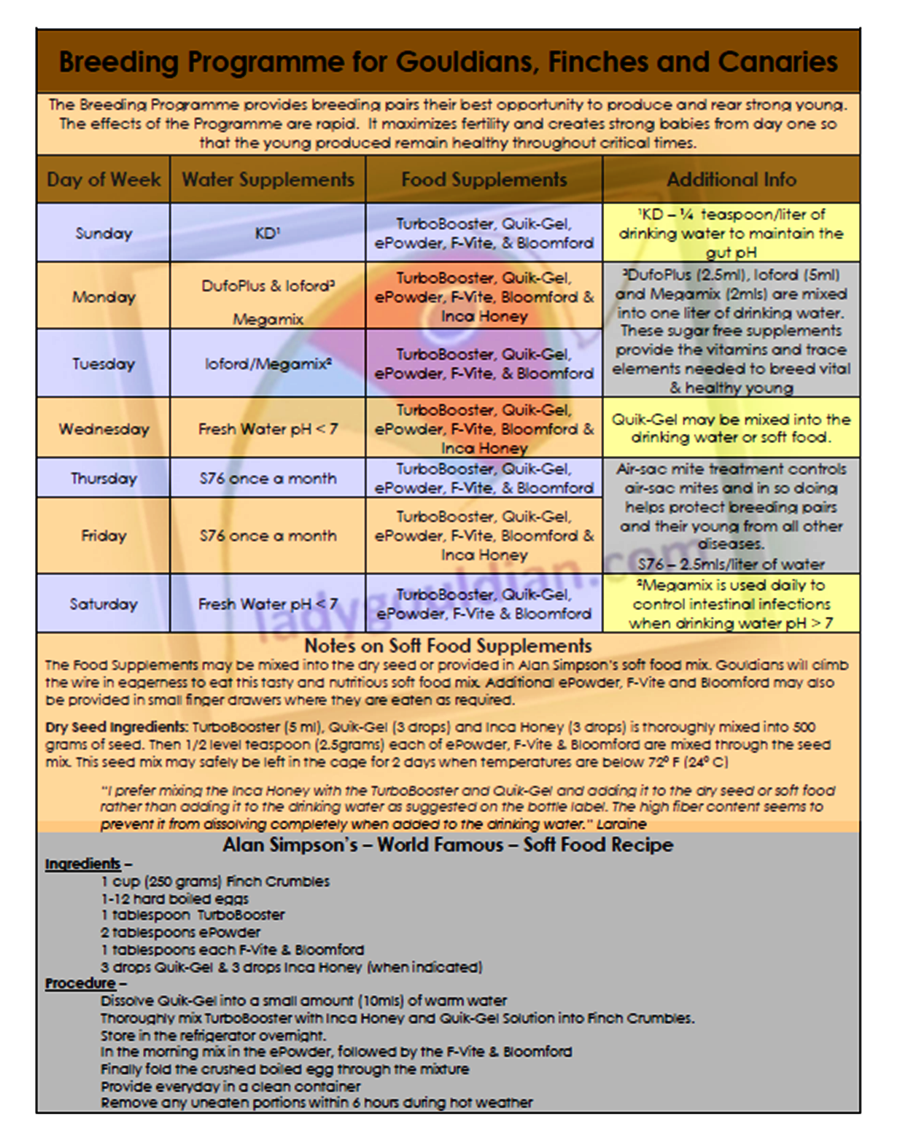
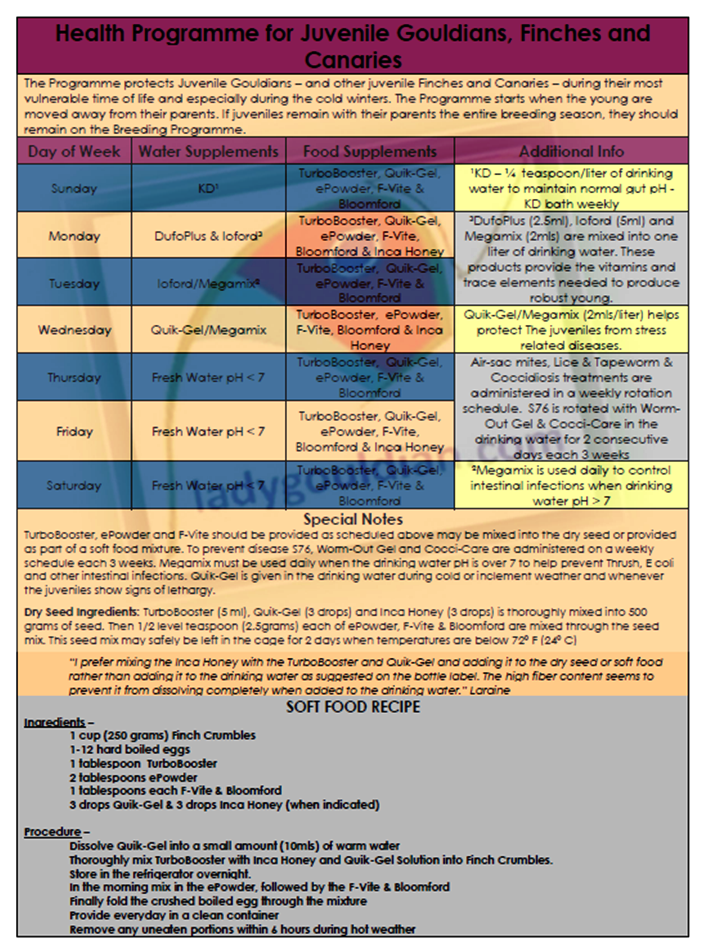
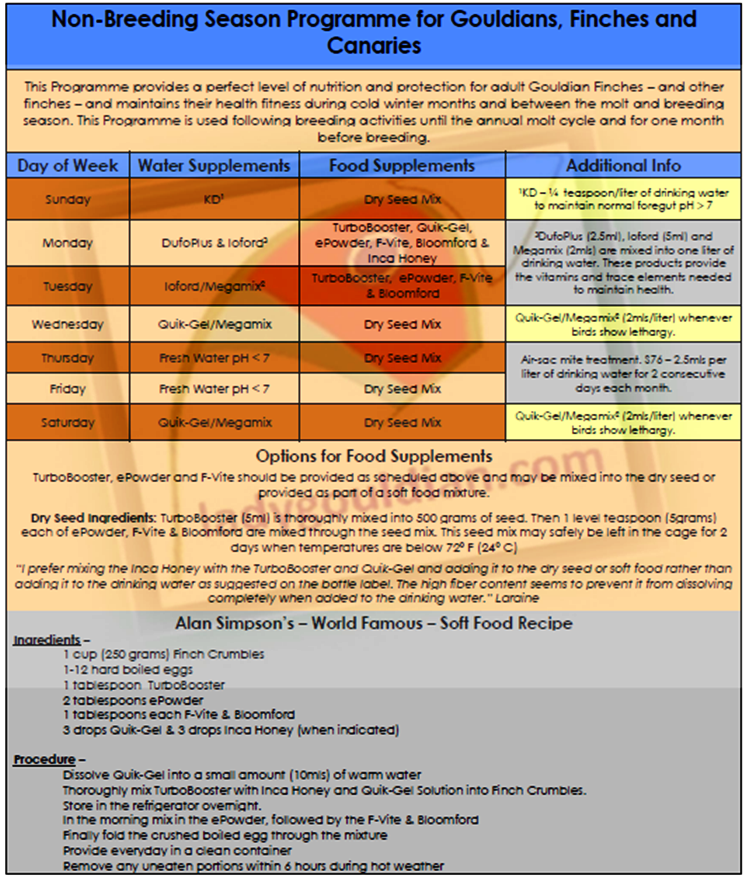
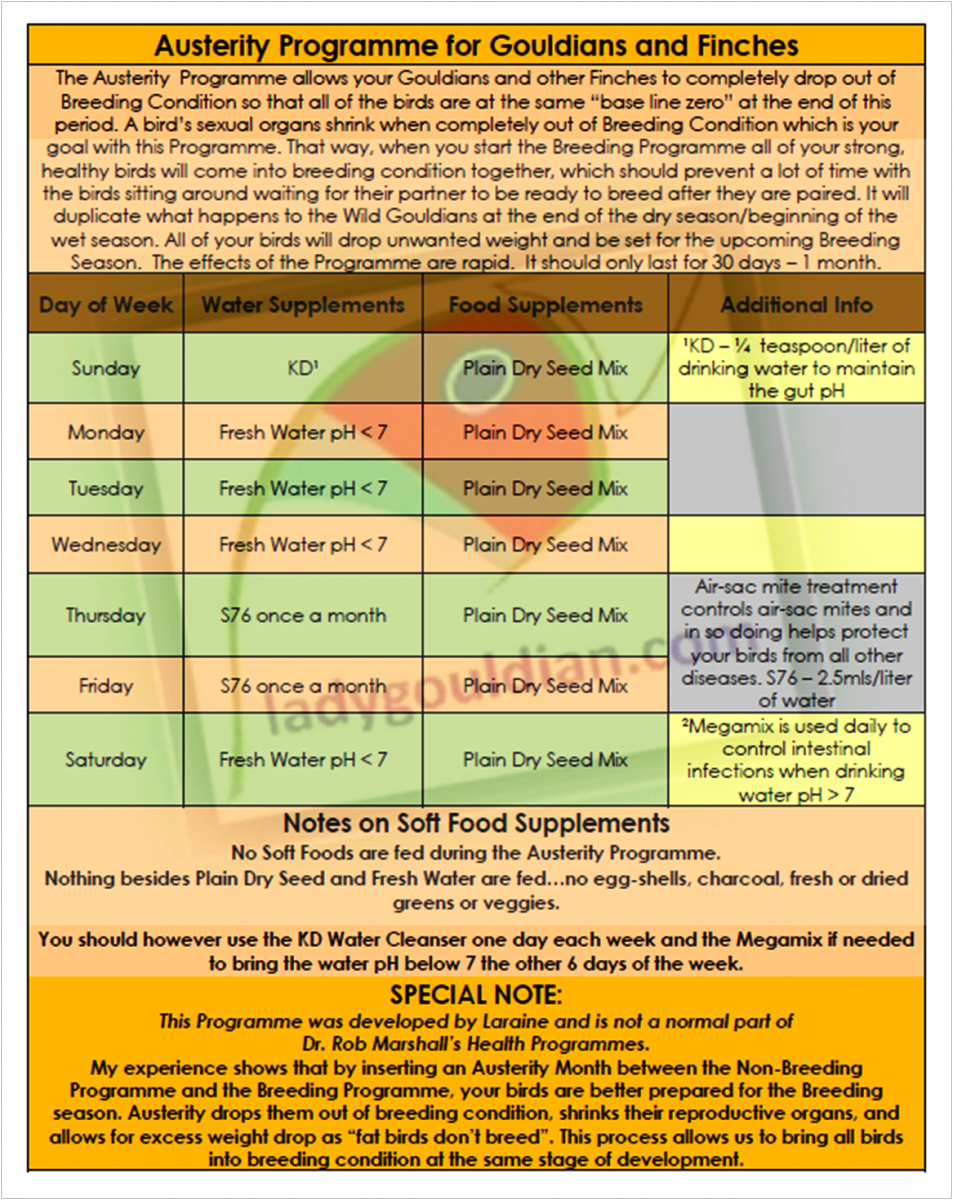
The System
During the Breeding Season if/when sprouted seeds and fresh egg mixtures are given to the birds, all of the supplements (TurboBooster, F-Vite and e-Powder and even the DufoPlus and Ioford) are easily added to these mixtures. F-Vite and ePowder should also always be offered "free choice" in separate treat cups during the Breeding Season. During the Resting phase each year when the birds should be on a pared down diet and not given such energy rich foods, adding the 3 core supplements (TurboBooster, F-Vite and ePowder) to the seeds on the appropriate days of each week is the most practical way of administering them. During this resting cycle, the DufoPlus and Ioford are best added to the drinking water.
A most important consideration In my discussions with other bird owners about changing to Dr. Marshall's feeding regimen, I have found that many of them were unable to alter their ability to provide the birds with a week's supply of seed, and, therefore, were not willing to try Dr. Marshall's products. This will be an important decision for you if you decide to make the change. As mentioned previously, during the Resting cycle, high protein and high energy foods like hard-boiled egg and sprouted seeds should not be fed, so coating the dry seed mix is an excellent alternative. I do not believe that you will be disappointed with the results. I guarantee that you will spend a lot less time preparing and feeding the birds than the time needed to prepare and feed fresh eggs and sprout seeds. I am not implying that you should not feed fresh boiled eggs or sprouted or soaked seeds during the Breeding Season. I fully intend to add both items back into my birds' upcoming Breeding Season diet. What I am saying is that if you find that you do not have time for the preparations, feeding the Health Programmes supplements coated onto the seed and added to the drinking water works beautifully and the parents and their offspring will be strong and healthy and happy.
Each evening I measured out the amount of seed that I knew my birds would consume in a 24 hour period. To this I added the TurboBooster. The recommended amount of TurboBooster for Australian finches living indoors is 5ml to 500g of seed (THESE ARE NEW DOSING RATES) . Dosage rates for other species of birds can be found in Dr. Marshall's books dealing with that species or on the supplement labels.
|
TurboBooster
500g seed equals 2 cups
5 ml TurboBooster |
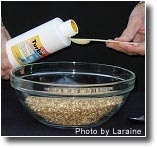 |
I must admit that using the TurboBooster was the biggest obstacle that I encountered when using this system. I just could not fathom how to make 1 teaspoon of TurboBooster coat 2 cups of seed. Dr. Marshall had told me that I could add sterile water to the pre-measured TurboBooster to make it spread further. I did this for a brief time, but found that this just made the seed wet, so I decided that since I wanted to use the products correctly, I would do as he had been recommending.
One of the changes that I made was to increase the amount of TurboBooster to seed. Dr. Marshall told me that the initial experiments to assess proper dosages of TurboBooster had been done on Gouldians living outdoors with exposure to bright sunshine and fresh air. These birds would naturally have benefits that my indoor birds do not have, even with the UV lighting that I had installed. So I am using 1 teaspoon (5ml) of TurboBooster to each 2 cups of seed. This is now the dosing rate recommended by Dr. Marshall after several years of testing with several Gouldian breeders in Australia.
When you read any of Dr. Marshall's writings, you will note that he states that you should "coat the seed" with the TurboBooster. Even with the increase in amount, there is still no way that the TurboBooster will coat each and every seed. What I found that you will be doing is spreading the measured TurboBooster as evenly as possible through out the seed. I did this with a fork, continually mashing the small liquid balls of TurboBooster into the seed. Once all the visible balls of TurboBooster were gone, I continued mixing with the fork until I felt that the seed that had been coated with TurboBooster was distributed evenly throughout the total seed volume. This whole process took me approximately 3 minutes. I would then cover the dish and let it sit on the kitchen counter overnight.
A 2nd change that I have made is to coat the seed with the TurboBooster each morning and have not found any difference in the health of the birds, but technically the coating is supposed to be done approximately 8 hours before feeding, allowing the TurboBooster to soak into the seed.
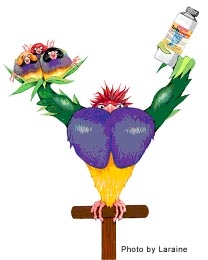 This coating of the TurboBooster was the Leap of Faith that I mentioned earlier. When I first started using the Health Programmes I just could not see how having the TurboBooster on only some of the seeds was going to be enough TurboBooster to have any effect on the health of my flock. But I am happy to report, that it indeed did have a startling effect. My birds have never looked better. The combination of the 7 supplements on that first year's crop of juveniles was spectacular. The red and orange heads and yellow bellies were brighter and deeper in color and the feathers are breathtaking. The birds were energetic and really seemed "happy" with themselves.
This coating of the TurboBooster was the Leap of Faith that I mentioned earlier. When I first started using the Health Programmes I just could not see how having the TurboBooster on only some of the seeds was going to be enough TurboBooster to have any effect on the health of my flock. But I am happy to report, that it indeed did have a startling effect. My birds have never looked better. The combination of the 7 supplements on that first year's crop of juveniles was spectacular. The red and orange heads and yellow bellies were brighter and deeper in color and the feathers are breathtaking. The birds were energetic and really seemed "happy" with themselves.
 In the morning sprinkle 1/2 teaspoon of F-Vite and 1/2 teaspoon of ePowder on top of the 2 cups of coated seed and using a fork blend and coat the seed. The F-Vite and ePowder will stick to every seed that has been coated with the TurboBooster. As the birds twirl the seed around in their beak to crack the hull, these supplements are ingested. This is the only "food" that I provided to the birds each and every morning for the year leading up to and through the breeding season in the fall of 2004.
In the morning sprinkle 1/2 teaspoon of F-Vite and 1/2 teaspoon of ePowder on top of the 2 cups of coated seed and using a fork blend and coat the seed. The F-Vite and ePowder will stick to every seed that has been coated with the TurboBooster. As the birds twirl the seed around in their beak to crack the hull, these supplements are ingested. This is the only "food" that I provided to the birds each and every morning for the year leading up to and through the breeding season in the fall of 2004.
It's that simple! Of course you could also offer greens or veggies several times per week during the Resting and Molting season and sprouts and eggfoods during the Breeding season, but since I was testing "bare bones" I offered nothing else to the birds from early December 2003 after my move through the breeding season from October 2004 to January 2005. My intention was to again offer the sprouted or soaked seed as well as a softfood during future Breeding seasons. However for each Breeding season after this first one on Dr. Marshall’s Health Programmes, I always seemed to find one excuse or another for NOT adding back the fresh boiled egg and sprouts. Time consideration was usually the main reason for not adding the fresh boiled egg and sprouts. The only birds that did get the fresh boiled eggs were my canaries during their Breeding Season because I found that they would not feed their babies properly when I offered them a dry commercial eggfood. So I did boil eggs and mix the TurboBooster and ePowder into this mixture. It is far easier to add the TurboBooster to a moist eggfood or sprouts rather than coated onto dry seed.
Liquid Supplementation
The DufoPlus and Ioford are the sugar free liquid vitamin and liquid mineral supplements that are added to the drinking water for varying numbers of days depending upon what time of year it is and which "season" your birds are going through. These 2 supplements can also be mixed into the softfood or sprouted seed during the seasons when this type of food is recommended. The 4 seasons listed by Dr. Marshall are Resting, Molting, Breeding and Juvenile. The complete schedule of use can be found in the Health Programme usage charts at the above link, or can be found in any of Dr. Marshall's books, Gouldian & Finch Health (This book is out of print but is now available on-line. E-mail me at Laraine@ladygouldian.com and request your access code for Dr Marshall's CLIENTS ONLY website) Canary Health, Pigeon Health or The Budgerigar. I highly recommend purchasing the book that best represents the type of birds that you live with, because they completely explain in much more comprehensive detail about all the products, their use and application in taking the best care possible of our birds.
|
Vitamins & Minerals for Finches Ioford |
|
|
|
|
During all the Health Programmes, the DufoPlus and Ioford are used together for 1 or 2 days, but in the Juvenile, Breeding and Molting Programme the Ioford is used alone for a second or third day. This is to provide the additional calcium and minerals needed by the breeding hens, growing juveniles and for quality feather growth. Both DufoPlus and Ioford should also be stored in the refrigerator upon receipt by you to ensure and protect the optimum quality of these supplements.
Water Additives
Megamix
Megamix is Dr. Marshall's first drinking water additive that prevents bacteria, mold and fungus (Thrush) from reproducing in the bird's drinking water. With Megamix this is accomplished by lowering the pH of the water into a range where these harmful organisms do not like to exist. An added benefit is that the drinkers remain free of sludge and sparkling clean.
The main benefit, however, is that it cleanses everything the bird ingests into the crop, thus decreasing direct contamination through the food and water and preventing fermentation of foods fed to chicks until it can be absorbed by the digestive tract. The rest of the digestive tract is pH adjusted into the acidic range where it should naturally be, which also protects the bird.
One huge benefit of using Megamix occurs when our pet birds are housed in very humid conditions on a daily basis. This will happen if they were housed outdoors in the southeastern US where I live, or near coastal waters, where the humidity can be in the 85%-90% range year round. It could also occur if your birds are housed in the basement of your home where humidity levels are usually higher than desired. A desirable range for pet birds would be 45%-50%.
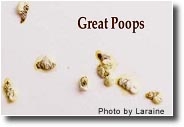 When birds are living in high humidity, the pH of their digestive tract rises into an unhealthy alkaline range which leaves them open to infection. The normal acidic state of a bird's gut is not a habitable condition for things like bacteria, fungus, mold and coccidian organisms. If these organisms are ingested by the bird, they simply pass on through without causing any problems. Once the gut begins to turn alkaline these foreign organisms can cause serious illness in birds that have not developed an innate resistance to these "wet environment" diseases. This would include any species that has it's origins in dry, arid environments.
When birds are living in high humidity, the pH of their digestive tract rises into an unhealthy alkaline range which leaves them open to infection. The normal acidic state of a bird's gut is not a habitable condition for things like bacteria, fungus, mold and coccidian organisms. If these organisms are ingested by the bird, they simply pass on through without causing any problems. Once the gut begins to turn alkaline these foreign organisms can cause serious illness in birds that have not developed an innate resistance to these "wet environment" diseases. This would include any species that has it's origins in dry, arid environments.
Illness in the birds happens because bacteria (Ecoli and Strep), mold, fungus (Thrush) and coccidia thrive in humid conditions. The birds have the possibility of ingesting these airborne toxins, which may have settled on their food and into their drinking water or simply by spending time on the ground where these organisms can live. Even in indoor aviaries and cages it is especially important to prevent water drinkers from leaking and causing damp places on the ground and cage floors because any moisture will provide excellent conditions for the colonies to multiply.
The higher humidity also predisposes them to drink more water which will make their droppings watery and poorly formed.
The amount of Megamix used will vary from aviary to aviary based upon the alkalinity of the local water. Normal city tap water has a pH of about 7.5 when it is full of chloramines. The pH will rise with more chloramines added. Therefore, city tap water predisposes a bird to bacterial, mold and Thrush growth on food and water ingested into the crop. With the addition of a water softener, the problem can be exaggerated even more. I have found that my normal tap water has a pH of 8.5 so I use the Megamix in the drinking water on all days that the KD Water Cleanser isn't being used.
The normal crop of a bird has a pH of 4; the proventriculus about pH 2; intestines and cloacae around pH 6.5-7. Megamix in normal tap water (approx. pH of 7.5) lowers the pH to 5.3 to 5.4. Therefore, if the normal drinking water has an even higher pH than 7.5, the addition of more Megamix will be necessary to bring the pH into the 5.3 to 5.4 range. The amount of Megamix needed can be determined by observation of the droppings…in a normal, healthy bird…which should be tight and well formed with just a small amount of water ring around them. Dr. Marshall recommends starting with 3ml of Megamix per liter of water. Observe the droppings for several days and adjust the amount of Megamix up in 2ml increments until the droppings are normal.
I am using the Megamix for the 5 days each week when I do not use the KD Water Cleanser. It is totally compatible with the DufoPlus and Ioford. I also use it with the S76 when treating for air-sac mites and worms each month. Megamix can and should be used with some drug cocktails discussed by Dr. Marshall in his books and on this website, but it will cause some of them to precipitate, so it can't be used with all medications.
KD Water Cleanser
Megamix and its sister product, KD Water Cleanser, are health products designed to maintain flock health by decreasing direct contamination through the ingested food and water. This in turn produces a dropping that has fewer germs; therefore, the environment is also kept cleaner. A clean environment is of great benefit when there are fledged juveniles who are just learning to eat on their own. As any bird breeder knows, chicks will hunt and peck around on the floor of their cage eating whatever may look like food. To them, droppings could be just as edible as seed. At this critical stage they have a very immature immune system so they do not need to be stressed by intake of harmful organisms that may be contained in these droppings. In this way, both Megamix and KD allow the immune system of the young birds to develop naturally without constant medications.
The KD Water Cleanser is used for 2 consecutive days each week to thoroughly cleanse the digestive tract of the bird. KD should never be mixed with any other product or supplement. It is meant to be used by itself for these 2 days. KD is active against Strep, Ecoli, Thrush, fungus and viral infections without affecting the immune system. In some cases you may find that KD is only needed for 1 day each week. This can be determined by observing the noise and activity level of your birds at the start of the 1st day of KD. If on the morning of the 2nd day you find that the noise and activity has increased, then the KD should be left for the 2nd day. If however the birds seem quiet or depressed, the KD should be removed and replaced with fresh water or fresh water with added Megamix. The KD water should also be replaced if the droppings have turned mushy and green. Both scenarios are an indication that the flock is healthy and may only need the KD for 1 day every 2, 3 or 4 weeks instead of every week.
If you find that you need KD for 2 days each week, this schedule should be altered when the parents are feeding chicks. Feeding birds will naturally drink more water than non-feeding birds and will get the required amount of cleansing with only 1 day during these feeding weeks.
KD Water Cleanser also makes an excellent soaking solution for soaking seed. It is mixed at the same rate that is used for the drinking water, ¼ teaspoon per liter of water. KD may also be used at a disinfectant strength (1 teaspoon per liter of water) to wash hand feeding tools or to clean trays and cage. It leaves no soap residue like dishwashing products. I use it this way to wash my water tubes and rubber stoppers each Saturday. Even though the water tubes stay sparkling clean on the inside because of the use of Megamix and KD, the outside of the tube gets nasty from all the head shaking the birds are prone to do after drinking.
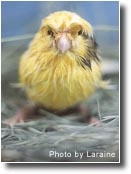 KD Water Cleanser can also be added to the bath water, at the drinking water strength (¼ teaspoon per liter of water), to wash away any debris and leave sparkling clean feathers. The exuberance with which the birds bath in the KD bath indicates to me that my birds seem to enjoy their KD baths much more than just plain bath water.
KD Water Cleanser can also be added to the bath water, at the drinking water strength (¼ teaspoon per liter of water), to wash away any debris and leave sparkling clean feathers. The exuberance with which the birds bath in the KD bath indicates to me that my birds seem to enjoy their KD baths much more than just plain bath water.
Quality is not expensive, IT'S PRICELESS!
"But his products are so expensive" Over the last 10 years I have heard these words spoken many times. My thoughts have always been that using Dr. Marshall's Health System wasn't more expensive because you use so little each day and several of the products are used only a few days each week. I thought perhaps you would like see exactly how much it would cost to use Dr. Marshall's products if price is what is stopping you from trying them.
I based this figure on 2 cups of seed mixed each day (500g), which for me would feed between 20 and 24 pairs of birds. It was also calculated using the suggested mixing rates for each product. Using all 7 of Dr. Marshall's products, the price per day to feed 48 finches would come to $1.77 per day, roughly $53.00 per month, or 4 cents per bird per day. Calculating the cost to feed the same number of birds with another supplement line is $1.25, approximately 52 cents less each day. However if the needed medications to keep the flock healthy were calculated, I feel certain that the cost would be about equal.
How many of you have 48 birds to feed each day? If you do have that many, you are probably a breeder, and not a hobbyist. Selling a few pair of birds each year would cover your supplement costs. Dr Marshall's Health Products will pay for themselves many times over just in increased chick numbers! To me the cost really isn't the issue. The issue is the health, well being and happiness of my birds. That is why I truly feel that Quality isn't expensive,
It is Priceless!
READ - An Ounce of Prevention
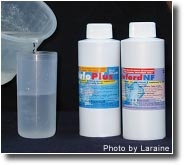 DufoPlus
DufoPlus



